The evidence suggesting hot water emanates from the soil of Enceladus, one of Saturn's icy moons, puts it at the top of the list of hot spots for extraterrestrial life.
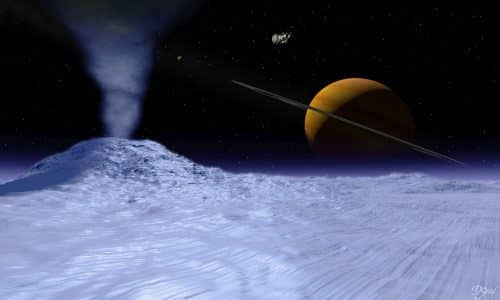
- Data from the Cassini spacecraft show that beneath the ice on Enceladus, Saturn's icy moon, there is an ocean releasing jets of seawater into space. The jets allow a glimpse into the heart of the moon.
- The study of the moon and the jets emanating from it helps scientists estimate the temperature and composition of the ocean of Enceladus and has revealed evidence of hydrothermal vents at its bottom.
- On Earth, hydrothermal vents sustain ecosystems and may have been a hotbed for the origin of life. The possibility of life on the surface of Enceladus depends on the age and lifespan of the ocean and the hydrothermal activity in it.
- Enceladus' ocean and hydrothermal activity cannot exist without the supply of heat from the moon's interior. Future missions may be able to find out the source of this heat and perhaps even discover extraterrestrial life for the first time.
If you were to make a list of the places where it is least likely to find a bustling city, you would surely put the bottom of the sea in the North Atlantic Ocean, halfway between Bermuda and the Canary Islands, at the top. But precisely there, in the darkness that prevails at a depth of almost a kilometer below the surface of the sunny waters, nature has established an underwater metropolis: a complex of limestone towers as tall as skyscrapers that serve as a home for multitudes of snails, crabs and oysters. The towers are formed when minerals crystallize as jets of hot and alkaline (alkaline) water erupt from openings of The hydrothermal origins found on the bottom. Biologists discovered this exotic "lost city" in the early 2000s using submarines and remote-controlled cameras, and since then they have been studying it and learning how thriving ecosystems can exist in these outcrops, so far from life-giving sunlight. And meanwhile, planetary scientists, using the spaceship Cassini Discovered in the outskirts of the solar system some revolutionary discoveries. They found compelling evidence that hydrothermal vents, which closely resemble those of the Lost City, are not unique to Earth. The evidence suggests the existence of such emanations at the bottom of a mysterious ocean that lies beneath the surface of one of Saturn's moons, a small, icy moon called Enceladus. Could there be life there too?
Naturally, the possibility of extraterrestrial life excites the imagination of scientists, but such hydrothermal vents would have fascinated them even without the possibility of aliens. The evidence of hydrothermal activity on this distant moon also provides vital information about the composition of Enceladus' ocean and its lifespan. If it weren't for this activity, these secrets could be buried forever under the frozen crust of the moon, as they are perhaps buried on other moons in the solar system, which also have oceans buried under the surface mantle, but so far no solid evidence of hydrothermal activity has been found on them, such as the moon Europa, For example, orbiting the planet Jupiter.
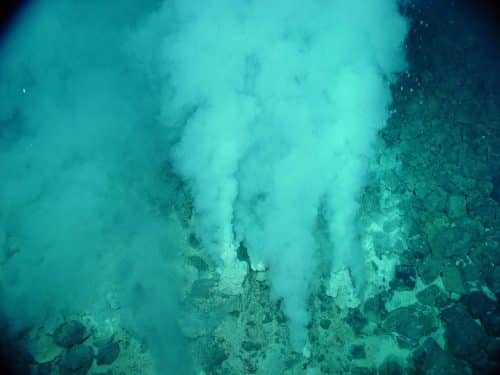
To get to the bottom of the matter, the very existence of the hydrothermal vents in Enceladus raises an enigma that cannot be ignored. Besides water, the other necessary ingredient in hydrothermal activity is heat of course. But it is not at all simple to explain why the bowels of this frozen moon are bubbling. Enceladus is a tiny moon - about 500 kilometers in diameter, about the width of England - much too small for it to retain primordial heat from the days of its formation. Other heat sources must therefore operate in its depths. If we understand how Enceladus produces the heat inside it and preserves it, a revolution may occur in the way we understand the ice-covered moons in the solar system and in the way we evaluate the chances of finding life on them.
First hints
Scientists began to suspect that there was an ocean inside Enceladus in 2005, about a year after Cassini arrived in the Saturn system. The spacecraft then noticed a huge plume of water vapor and ice grains being emitted from a tectonically active area near the south pole of the moon and rising to a height of hundreds of kilometers in space. Then, in a series of flybys conducted by the spacecraft near Enceladus, she identified that the transmutation was due to several jets breaking out from four linear fissures. The cracks are hotter than their cold surroundings and therefore glow in the infrared. The mission scientists named these cracks the "tiger stripes" and identified the jets bursting from them as the source of a faint ring of ice particles that extends around Saturn. this ring E ring, is the outer one in Saturn's classical ring system. However, most of the ice grains ejected into space by these jets move too slowly to reach the E ring and fall back on Enceladus as thin snow. Based on the mounds of snow that cover several parts of the southern half of Enceladus and rise to a height of about 100 meters, the researchers estimate that the moon has been spewing water into space for 10 million years or more.
The "ocean hypothesis", put forward to explain Enceladus' water jets, was initially controversial. But a long series of studies conducted using Cassini proved unequivocally that a deep global ocean is indeed hidden inside the moon. Annarday Chadak from Charles University in Prague and his colleagues, including one of us (Toby), recently conducted an analysis of Enceladus' gravity field, its surface topography, and the slight wobble of its rotation axis. Based on the results of this analysis, the researchers placed the tightest constraints yet on the ocean's extent and volume. Their calculations show that the thickness of the crust near the equator of Enceladus must be about 35 kilometers, but less than 5 kilometers in and around the south pole. The bottom of the ocean, it turns out, is at a depth of 70 kilometers below the surface, and therefore the amount of water in the sea of Enceladus is about a tenth of the amount of water in the Indian Ocean. And according to the data collected by Cassini in 2009 and 2011, one of us (Postberg) showed that the splashing water is alkaline and contains sodium chloride (table salt). This composition is due to the fact that the ocean is probably located above the rocky core of the moon (from which minerals dissolve).
The decisive evidence for the existence of hydrothermal vents in Enceladus was already received in 2004, even before Cassini even reached Saturn and discovered the turbulent transformation from this moon. As Cassini approached Saturn from interplanetary space, it was hit by unexpected showers of microscopic, fast-moving nanoparticles that hit it like shotgun pellets. The particles were discovered using a special device installed on the spacecraft to analyze the composition of the dust in space, the so-called device CDA (acronym for "Cosmic Dust Analysis Device"). Years later, after the transmutation was discovered, Postberg returned and examined the CDA data to examine the size distribution of the particles and their frequency. He found that none of them exceeded 20 nm in diameter and that the composition of all of them was similar: Carbon dioxide Pure, also known as silica, the main component of quartz rocks and sea sand. Xiangan--Won Hsu from the University of Colorado at Boulder calculated using computer simulations the most likely trajectories of these nanoscale silica particles, and concluded that they originated at the outer edges of the EE ring. Since we know that it is Enceladus that creates the E ring, this finding strengthens the hypothesis that these particles did come from the icy moon. The composition of the particles, it turned out, was the decisive evidence in the discovery of the hydrothermal activity in Enceladus.
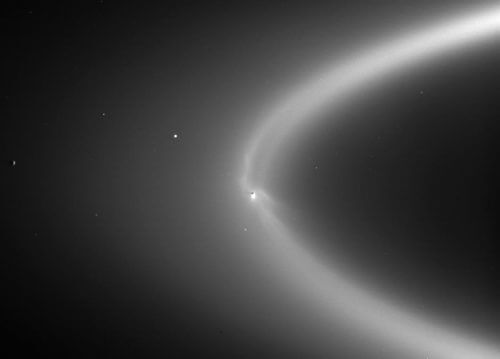
The fact that pure silica spews from Enceladus surprised the scientists because the only likely source of silica is in the rocky core of the moon, deep beneath the ice and ocean, where iron is found mainly in minerals, chemically bound to other elements such as iron and magnesium. Silica nanoparticles may form in the grinding of these minerals as the rocks containing them collide with each other and shatter into smaller and smaller pieces. But if this did happen, the particles should have been found in a wide range of sizes, and not in such a narrow range as in Cassini's observations. There is therefore only one natural explanation left: the particles formed from a hot and alkaline aqueous solution, supersaturated with silica, which flowed through cracks in the rock - that is, from hydrothermal vents just like those discovered in the "Lost City" on Earth.
Is there life in the ocean?
In the "Lost City", and perhaps also in the seabed of Enceladus, as hot water flows upwards between the silicate rocks, it dissolves some of the silica. When the water bursts from the openings out into the surrounding sea, it cools, the amount of minerals able to dissolve in it is small, and the nanometer silica particles crystallize. At this point, other molecules can attach to the particles, making them larger and increasing their weight, until they eventually sink to the bottom. Unless the water is alkaline and not too salty. This relationship, between the size of the particles and their duration of existence and between the temperature and chemical composition of their aqueous homeland, opens for scientists a rare peek into the environmental conditions that prevail in the ocean of Enceladus.
After the first discovery of the nanoscale particles by Cassini, a team of researchers led by Yoshihito Sakina From the University of Tokyo laboratory experiments to test how the particles are formed and to find out the conditions in the depths of Enceladus. The group's scientists discovered that the optimal conditions for creating small, long-lived silica nanoparticles prevail in water whose temperature is 90 degrees Celsius or more, whose level of alkalinity is higher than that of seawater on Earth but whose salinity is slightly lower. From the experiments it emerged that the degree of alkalinity of the ocean of Enceladus should be between that of seawater on Earth and that of household detergents based on ammonia. If they are more basic than an aqueous solution of ammonia, the solubility of silica in this water will be too high and will not allow the crystallization of nanoparticles. If the water is less alkaline than seawater on Earth, it must be unbelievably hot to melt enough nitrogen dioxide to form nanoscale silica particles.
The combination of Hsu, Postberg and Sekina's findings therefore raises the possibility that the rich ecosystem of the "Lost City" and other hydrothermal vents on Earth may survive if they copy it to the depths of Enceladus. In other words, it looks like the ocean of this distant icy moon could support life.

It is possible, of course, that today's Enceladus is a hostile place for life and that the silica particles discovered by Cassini are just remnants of ancient hydrothermal activity that has long ceased. But the work of Sekina and other partners shows that this is not the case. Laboratory experiments and computational models show that the average diameter of a newly formed silica particle is about four nanometers. The particles can add and grow in a time span of a few months to a few years at most. The CDA data show that a typical Enceladus particle is between 4 and 16 nanometers in diameter, with none exceeding 20 nanometers. Therefore, the nanoparticles collected by Cassini must have formed only a short time before they were measured, otherwise they would have been larger. This is the best evidence we have that, as you read this article, the hydrothermal vents on the sea floor of Enceladus are raging.
From the depths of the sea to the depths of space
Based on the geochemical mechanism we discovered, we can now trace the journey of a typical nanoparticle from the bottom of Enceladus' subterranean sea out into the vastness of the solar system. After the particle forms at the cooling edge of a warm, silica-rich solution flowing into the cold ocean water, it drifts upward over a few months or years and soaks about 60 kilometers of seawater.
When it reaches the surface of the water, the particle rises in cracks filled with water that cross the length and width of the icy crust of the South Pole, which is several kilometers thick. Since the sea water is denser than the surrounding ice, the particle's upward progress should stop less than a kilometer below the surface of Enceladus. But here he gets another boost from a factor known as the "champagne effect": carbon dioxide is also dissolved in the water, and when they rise and the pressure on them decreases, they fizz in carbon dioxide bubbles like a carbonated drink. These bubbles help raise the sea water probably up to a distance of about 100 meters from the surface of Enceladus.
There, we surmise, they hope in ice caves. The low pressure that prevails in pools that swim so close to the extreme vacuum of space causes the water to bubble as carbon dioxide bubbles rise in them and explode. The bubbling pools therefore emit clouds of mist and water vapor. The tiny mist droplets soon freeze into ice grains a few microns in diameter, and within them lie the silica particles like raisins in a bun. The steam rises up like a chimney through cracks in the brittle and dry ice that is near the surface of the ground. Some of the steam freezes on the sides of the ice and releases capsule heat which we see as an infrared glow in the "tiger stripes" on the surface of Enceladus. The unfrozen vapor carries the grains embedded in the particles to the surface and launches them into space in fountains of ice.
Most of the grains in Timra fall back to the ground as snow, but the fastest ones escape from Enceladus and accumulate in ring E. In this ring, ionized gas erodes the ice grains and releases the nanoparticles contained in them. The freed particles then accumulate an electrical charge from the ionized gas and free electrons and succumb to the enormous electromagnetic fields of Saturn. Finally, with the help of the solar winds, some of those nano-particles reach speeds of up to a million km/h - about 0.1% of the speed of light - and soar into the solar system. A few of the escaped particles can even reach interstellar space and glide through the space between the stars.
Hot topics
As complex, beautiful, and in our opinion, true as this story is, it does not answer what was the central puzzle regarding Enceladus: what is the source of the internal heat necessary to maintain its dynamic ocean. This heat, which is essential for the existence of liquid and living water, does not come from the sun of course. The sun's rays on Enceladus are about 99% weaker than the light in the Earth's environment, and the surface temperature of the icy moon is therefore close to that of liquid nitrogen.
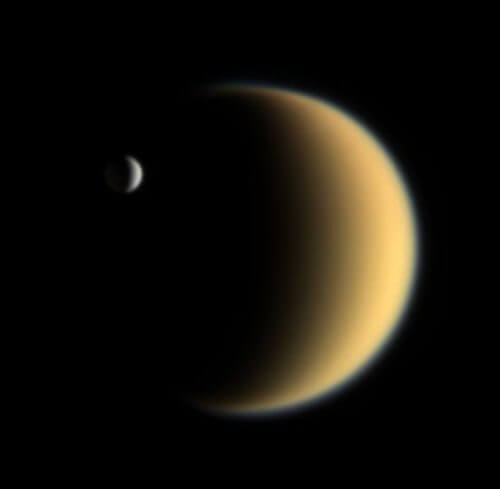
About half of the Earth's internal heat comes from the slow decay of radioactive isotopes of uranium, thorium and potassium. The radiogenic heating This has been maintaining temperatures of thousands of degrees Celsius inside the earth for billions of years. Although Enceladus presumably contains similar concentrations of radiogenic elements, the small moon, which is only about 500 kilometers in diameter, emits its internal heat much more efficiently than Earth. Without an additional heat source, Enceladus' core should have been frozen like stone. The Moon's small size and weak gravity also result in very different internal dynamics than heavier planets like Earth: the low pressure and low temperatures inside Enceladus limit the compaction and solidification of material in our cores, allowing water to seep down through porous rocks and drive actual hydrothermal processes in the center of the moon. On Earth, on the other hand, the rapid increase in underground pressure and temperature limits the water cycle to the upper kilometers of its crust.
It is likely that this flushing of Enceladus' core will drive the radiogenic heat from the core, accelerate its cooling, and prevent the high temperatures necessary for the formation of nanoscale silica particles. But besides the usual radiogenic heating, there is another source of energy that can explain the current hydrothermal activity on the Moon: tidal energy.
In Earth's oceans, the gravity of the moon and the sun cause tides. Similarly, tidal forces may cause the heating of a planet or moon through the cyclic contraction and expansion of its interior. This occurs when the celestial body moves in a longitudinal non-circular orbit. The deformation caused by the changes in gravitational forces creates friction within the inner layers of that sky mass, and the friction produces heat. Heating due to tidal forces would be especially strong in a porous, water-soaked core like that of Enceladus. Indeed, the Cassini data clearly show that Saturn's tidal forces have a considerable effect on the tiny moon. The brightness of its erupting jets, and therefore the amount of material ejected in them, changes cyclically with the Moon's rotation around the ringed planet. Apparently, the chimney-like cracks that carry the fog and water vapor through the ice sheet are crowded and spread due to tidal forces that also produce a significant amount of heat.
tide suits
What we don't know is whether the ocean we see today is a transient phenomenon lasting only a few tens of millions of years or a long-term feature of the moon, lasting for hundreds of millions of years if not billions of years. The answer depends on how long the tidal action warms the interior of Enceladus, and that depends on the extent of the Moon's influence on Saturn as well as its lunar neighbor Discussions.
To understand these gravitational interactions, one can look at the familiar system of our Earth and Moon, a system somewhat similar to that of Saturn and Enceladus. Our moon creates a tide on Earth, and Enceladus does so on Saturn. In the Earth's oceans, tidal currents are gradually weakened by friction with the coastline and with the seabed, an action that measurably slows the Earth's rotation around itself. Another century, the day will be two thousandths of a second longer than it is now, and the Earth will already have absorbed enough lunar tidal energy to increase the distance of the Moon from it by almost four meters. Similarly, the tidal friction inside Saturn has a tiny effect on the rotation of the giant planet, pushing Enceladus away from it and increasing the distortion (eccentricity) of its orbit. The greater the eccentricity, i.e. the longer the orbit, the stronger the tidal effect and the greater the heating inside Enceladus. According to early theoretical estimates, Enceladus was supposed to cause only a weak tidal friction on Saturn and return to a more centered orbit, so that the lifetime of any ocean in it, heated by the tidal effect, would not exceed a million years.
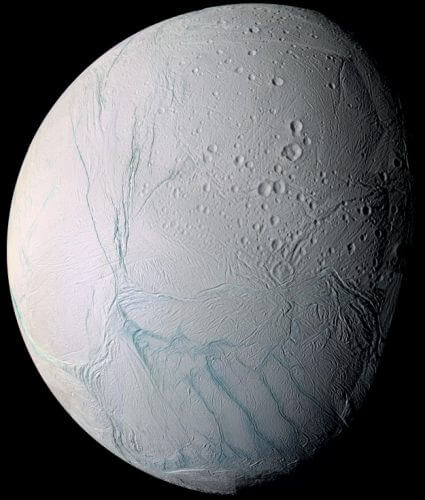
Recently, they did Valerie Lenny from the Paris Observatory and collaborators (including Toby) detailed analysis of the motion of Saturn's large moons to place tighter constraints on the strength of tidal friction in the giant planet's interior. They found that tidal friction inside Saturn is at least ten times stronger than previous models predicted. If so, this large value means that Enceladus moves in an orbit whose eccentricity is stable and long-lived, allowing for a strong tide that can sustain an ocean for at least tens of millions of years, and possibly much longer. The longer Enceladus' ocean can exist, one must assume, the greater the chance that life will thrive in it.
A brave new underwater world
Meanwhile, there is another possible heat source to consider besides tidal energy. When water permeates a silicate rock, it can penetrate the crystalline structures of certain minerals, or hydrate them, changing them chemically. This process, known as serpentinization, releases significant amounts of heat. Serpentinization, enhanced by the available flow of water in the porous, silicate-rich rock core of Enceladus, can generate power of several gigawatts and be a crucial component of the Moon's internal heat budget. As long as fresh, unaltered minerals come into contact with the flowing water, this heat source will work. But after millions of years, when the rock is fully serpentinized, heat will no longer be generated in this way, and without other influences, such as tidal friction, it will begin to cool. Therefore, it seems that serpentinization alone cannot sustain a global ocean long enough for the development of chemistry that might create life.
Nevertheless, serpentinization could still contribute to a possible biosphere in the depths of Enceladus. On Earth, scientists have discovered serpentinization processes that drive hydrothermal vents in the "Lost City" and other underwater sites. Besides heat, these reactions also produce hydrogen, methane, and other organic compounds that feed on bacteria and similar tiny creatures. These creatures in turn form the base of the food chain of this isolated ecosystem, far from sunlight. Some of the scientists who studied these organisms wonder after their research if sunlight is even necessary for life to exist.
In the late 80s, they raised Michael Russell, who was then at the University of Strathclyde in Scotland, and his colleagues hypothesized that basic hydrothermal vents may have been the birthplace of the first living organisms on early Earth. Although at the time they did not know about such emanations on Earth, Russell claimed that in such places an environment could exist where the conditions are moderate and yet it is high in energy. Such an environment enabled the existence of the chemical reactions that preceded the appearance of life and created the initial versions of contemporary biochemistry: membranes, metabolism and self-replicating molecules. Few took the idea seriously and it did not provoke discussion or debate except in limited academic circles.
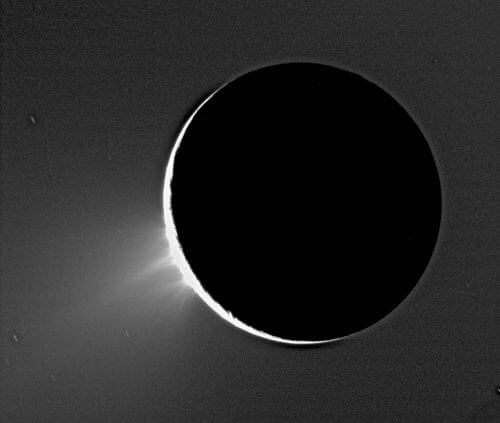
The discovery of the "Lost City" renewed interest in Russell's hypothesis and placed it at the forefront of the contemporary debate regarding the origin of life. Now the discovery of similar environments within Enceladus, and the possibility of their existence also on other icy moons such as Jupiter's Europa, creates another turn in our thinking about the possibility of life elsewhere in the solar system. Biology does not have to be confined to the warm, wet surfaces of rocky, sunny planets, but can perhaps thrive in a much wider variety of environments and subsist in whole or in part on heat from radioactive isotopes, serpentinization, or tidal forces. Enceladus and Europa may literally be just the tip of the iceberg: hints that subsurface oceans may also exist inGanymede And bCallisto, the moons of Jupiter, as well as inTitan, Andtiring, Saturn's moons, and perhaps also on the dwarf planet Pluto. Researchers interested, like ourselves, in extraterrestrial life are just beginning to examine these hypotheses and their implications, but it seems increasingly likely that we have so far greatly underestimated the biological fertility of the universe.
For now, we have no choice but to remain without an answer to the question of whether the interior of icy moons really provides the necessary ingredients for life outside of Earth. We still do not know the duration of the hydrothermal activity inside Enceladus and its intensity, and the discussion about the possibility of hydrothermal activity inside Europa is almost nothing more than a wild hypothesis. NASA and the European Space Agency are actively looking for answers to these questions and plan to launch a spacecraft to the icy moons of Jupiter. These will be able to look for changes like that of Enceladus in the late 20's or early 30's of this century. The Cassini spacecraft will continue to study Enceladus until the end of its mission in 2017, when it will crash into the depths of Saturn to prevent any possibility of contamination of Enceladus or another icy moon with biology from Earth. Eventually, a new generation of spacecraft could be sent there to do research in the field, land on the moon, and even collect samples to bring back to Israel. For now, such missions exist only in the hopes and dreams of astrobiologists - but that may soon change.

3 תגובות
We are looking for life as we know it, because it is the only thing we know, and because the stars closest to us are desolate. It is nice to see a joint effort by several countries for research, and long-term thinking about the preservation of potential life on these moons.